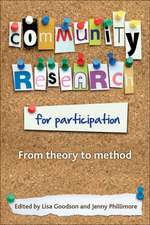Analyzing Talk in the Social Sciences: Narrative, Conversation and Discourse Strategies
Autor Katherine Bischoping, Amber Gazsoen Limba Engleză Paperback – 23 noi 2015
The book will help you choose strategies for qualitative analysis that best suit your research. It walks you through key decisions, provides actionable game plans and highlights the advantages and challenges of the main approaches. It is packed full of real examples designed to showcase the different tools you might use to meet your own objectives.
Each section of the book focuses on one popular strategy for analyzing talk-based data:
- Narrative Analysis
- Conversation Analysis
- Discourse Analysis
This book is both starting point and map for any social scientist looking to strategically and purposefully analyse talk data.
| Toate formatele și edițiile | Preț | Express |
|---|---|---|
| Paperback (1) | 395.43 lei 6-8 săpt. | |
| SAGE Publications – 23 noi 2015 | 395.43 lei 6-8 săpt. | |
| Hardback (1) | 917.10 lei 6-8 săpt. | |
| SAGE Publications – 25 noi 2015 | 917.10 lei 6-8 săpt. |
Preț: 395.43 lei
Nou
75.66€ • 79.21$ • 62.61£
Carte tipărită la comandă
Livrare economică 07-21 aprilie
Specificații
ISBN-10: 1446272494
Pagini: 240
Dimensiuni: 170 x 242 x 22 mm
Greutate: 0.43 kg
Ediția:1
Editura: SAGE Publications
Colecția Sage Publications Ltd
Locul publicării:London, United Kingdom
Recenzii
Its strength lies in its unique perspective, appropriate use of examples, comprehensive yet concise synthesis of existing literature, and grounded summary of analytic strategies.
A pleasantly readable and remarkably helpful guide that offers as much to experienced researchers as it does to novices. It clearly presents the “how’s” of narrative, content and discourse analysis while simultaneously dealing so thoughtfully with the “why’s” of these approaches.
The authors are attentive to all aspects of the interview, and identify a generally unaddressed and possibly major flaw of the qualitative method by discussing how memories are altered in retrospect and collective, not just individual, in character
A rewarding read as it crystallizes the differences and similarities among three popular approaches to analyzing talk data; it synthesizes key terminology, assumptions, relevant studies, intellectual traditions, and theoretical developments from a variety of fields. It will provide essential analytical skills and resources for faculty advising research, guided by narrative analysis, conversation analysis, and discourse analysis, and readers curious about these analytical approaches.
A helpful and much-needed guide. Meticulous attention is given to the consistency of ontology, epistemology, analytic strategy, and the criteria of rigorous analysis. Its strength lies in its unique perspective, appropriate use of examples, comprehensive yet concise synthesis of existing literature, and grounded summary of analytic strategies.
The main merit of this book is that it demonstrates how the choice for each of these strategies is related to ontological (what can be known) and epistemological (how we know) principles. The authors succeed with brilliance in order to untangle these Gordian knots for novice researchers by conveying the concrete application of relevant analytical concepts in a very clear way. Thanks to the accessible, pleasant writing style, anyone who wants a general overview of the most common methods in Na, CA and DA, can read this work smoothly from start to finish.
Cuprins
Chapter 1: Introduction
PART ONE: ANALYZING NARRATIVES
Chapter 2: Broad Strokes Approaches to Narrative Analysis
Chapter 3: Fine-Grained Analyses of Meaning
Chapter 4: The Interview in Narrative Analysis
PART TWO: ANALYZING TALK-IN-INTERACTION
Chapter 5: The Basics of Conversation Analysis
Chapter 6: Conversation Analysis Approaches to Social Categories
Chapter 7: Institutional Talk-in-Interaction
Chapter 8: The Interview in Conversation Analysis
PART THREE: ANALYZING DISCOURSE
Chapter 9: Foucauldian Discourse Analysis
Chapter 10: Critical Discourse Analysis
Chapter 11: Garden-Variety Discourse Analysis
Chapter 12: The Interview in Discourse Analysis
Chapter 13: Conclusion
Descriere
Talk is one of the main resources available to qualitative researchers. It offers rich, meaningful data that can provide real insights and new perspectives. But once you have the data how do you select an appropriate means of analysis? How do you ensure that the approach you adopt is the best for your project and your data?
The book will help you choose strategies for qualitative analysis that best suit your research. It walks you through key decisions, provides actionable game plans and highlights the advantages and challenges of the main approaches. It is packed full of real examples designed to showcase the different tools you might use to meet your own objectives.
Each section of the book focuses on one popular strategy for analyzing talk-based data:
- Narrative Analysis
- Conversation Analysis
- Discourse Analysis
Taken together these sections will help you to fine-tune the link between your primary research question and your methods; to ensure that your theoretical stance fits with your methods; and to reason through your analysis in a way that will be recognizable to the intellectual communities of narrative, conversation, or discourse analysts.
This book is both starting point and map for any social scientist looking to strategically and purposefully analyse talk data.











